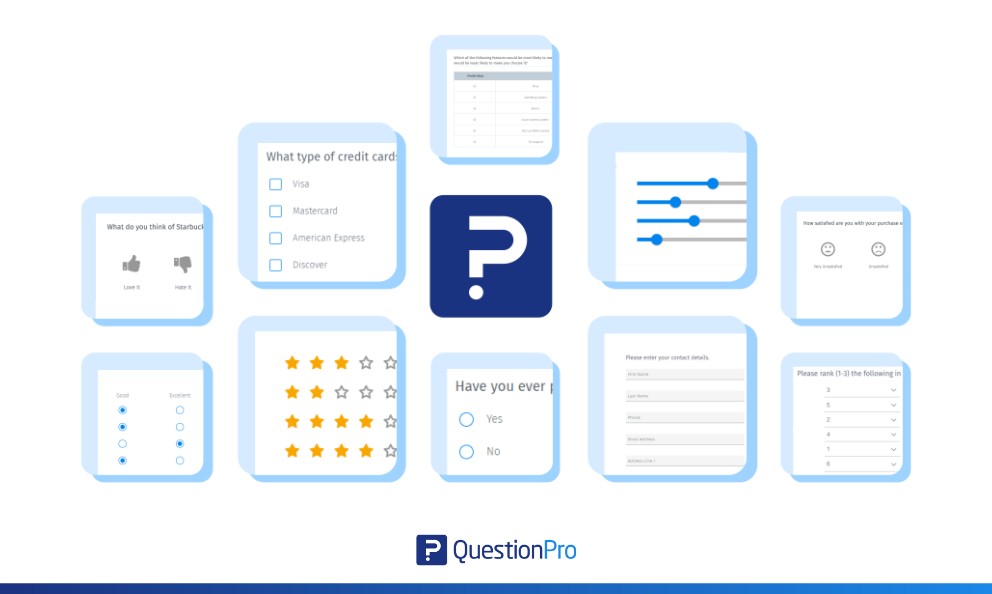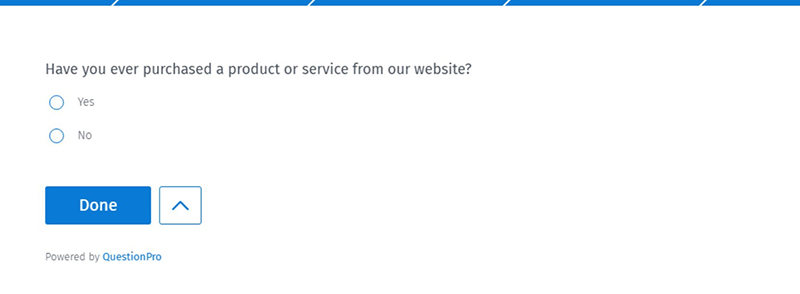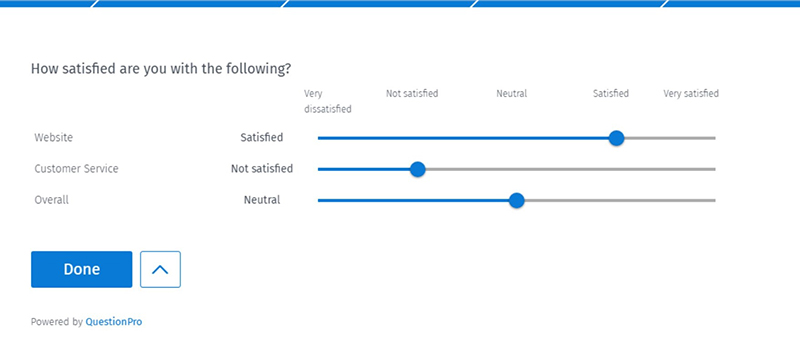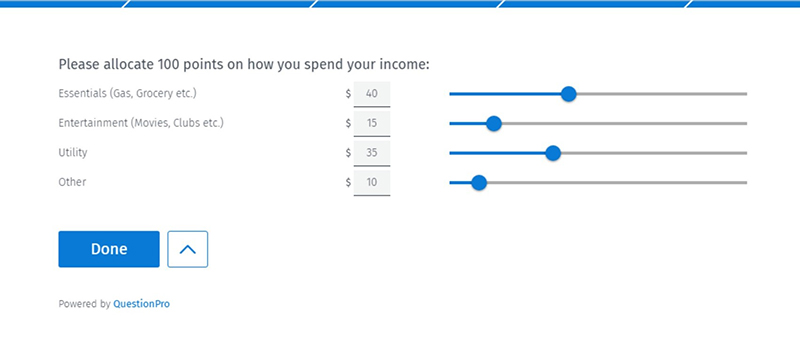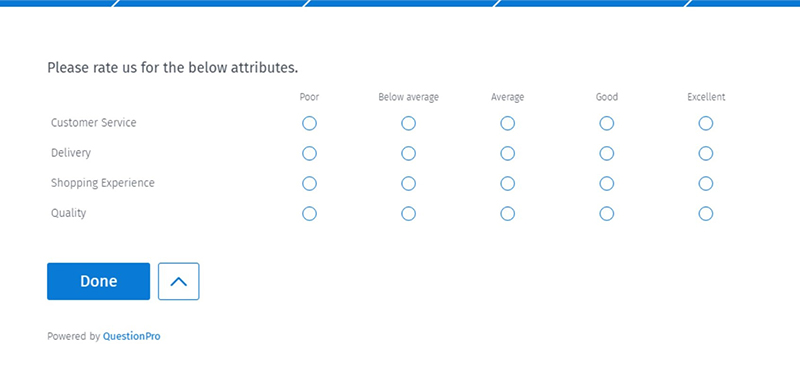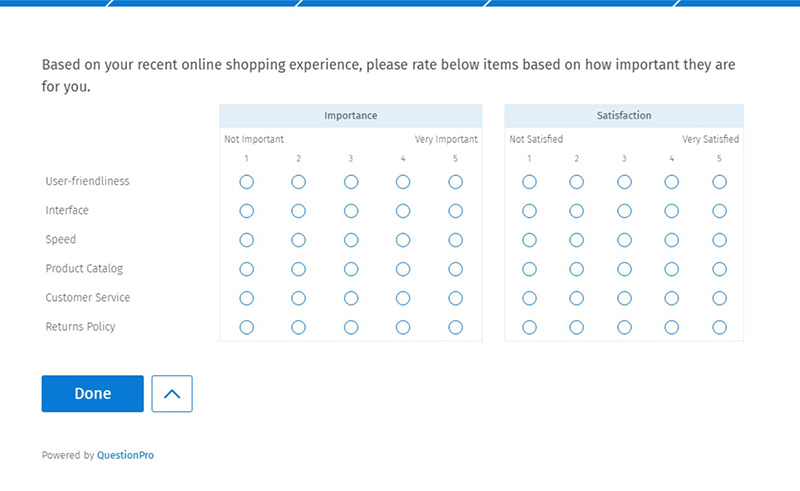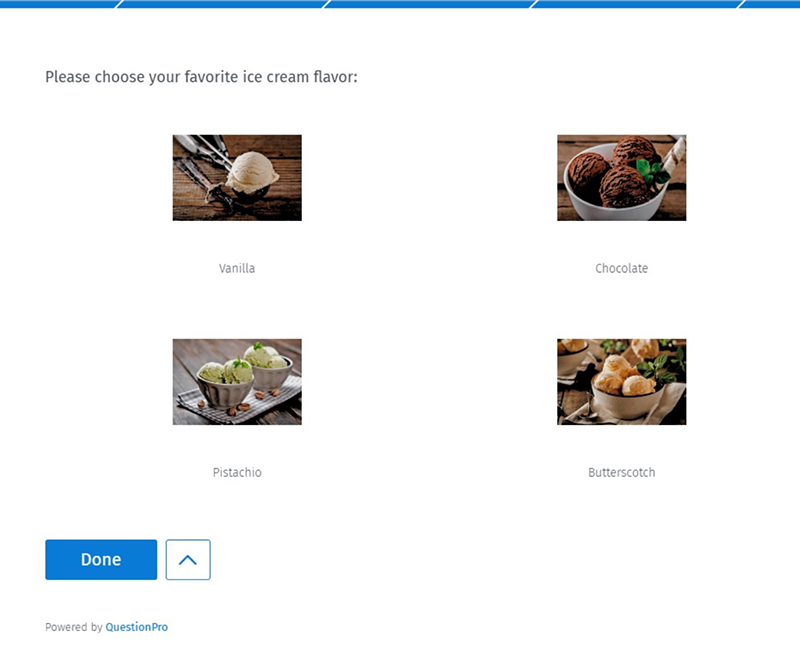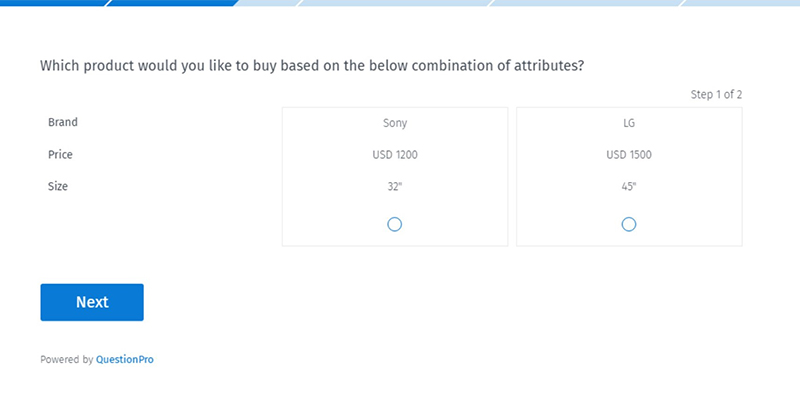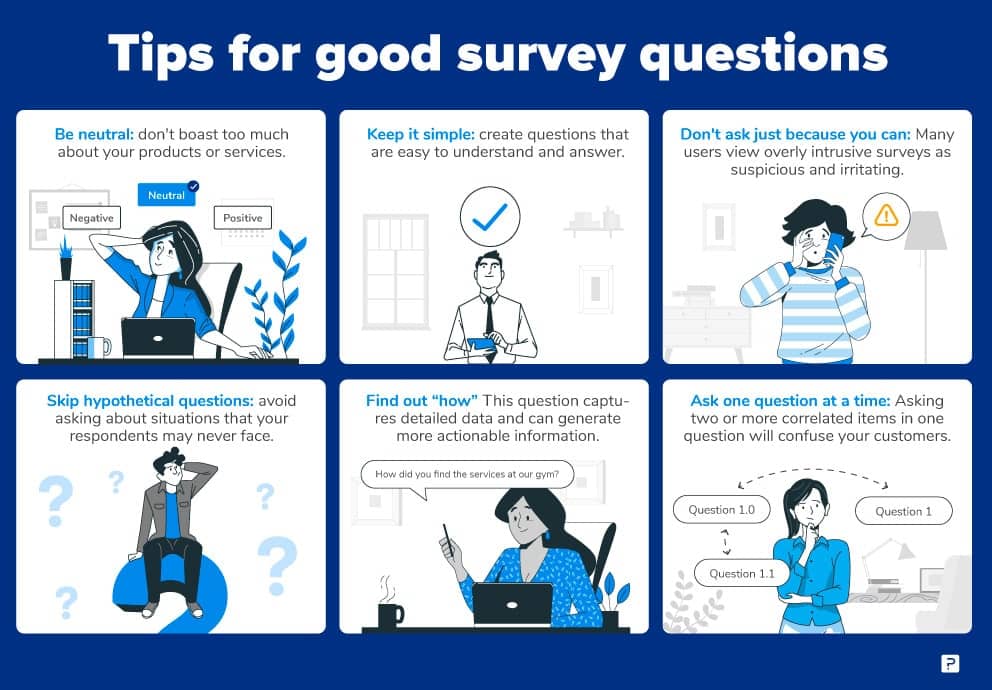The types of questions you ask can prove to be one of the most critical factors determining the success of a survey.
From email to SMS surveys, the common denominator that determines effectiveness is the questions. Different question and answer types promote multiple answers, even for similar questions.
This guide covers the types of survey questions and looks at what makes good ones. We'll also explore examples and give you access to sample survey questions as a template for writing your own.
Popular Survey Questions and Examples
Using different question-and-answer types effectively leads to more engaging surveys. Incorporating the different types gives you more complete and accurate results.

Dichotomous is generally a "Yes/No" question. It's often a screening question to filter those who don't fit the needs of the research.
Dichotomous question example:

For example, you want to know information about people who use your products. This type of question screens respondents to determine if they own your products. Those who have been to buy move to the end of the survey.
Dichotomous questions can also separate respondents by a specific value. For example, this might be those who "have purchased" and those who "are yet to purchase" your products.
The survey then asks different question sets to the two groups. You may want to know the satisfaction of the "have purchased" group. For the other set of respondents, you can learn more about their reasons for not buying products or services.
The multiple-choice survey questions consist of three or more exhaustive, mutually exclusive categories. Ask for either single or multiple answers. In the following survey questions example, the user selects only one out of the seven provided. You could configure this question to allow users to select multiple answers, such as all of the above responses.
Multiple choice survey question example:

Remember to include a category for "other" answers to serve as a catch-all for users not represented in the choices you provide.
Rank order scaling types of survey questions allow the ranking of brands or products. You list options and ask users to rank them on specific attributes or characteristics. Consider a fitness tracker company that wants to know what features their users like the most. List down the features and ask your respondents to rank the options based on how much they like them.
Rank order scaling survey example:

A rating scale question requires a person to rate a product or brand within a well-defined range. Rating scales measure the direction and intensity of attitudes.
Rating scale survey question example:

The Semantic Differential Scale question asks a person to rate a product, brand, or company on a seven-point rating scale. The ends of the scale feature polar-opposite adjectives, for example, "Very unlikely" to "Very likely". A typical example is asking customers to rate their willingness to purchase the product again.
Semantic differential scale survey example:

Unlike the rating scale, the semantic differential scale does not have a neutral or middle selection. A person must choose, to a certain extent, one or the other adjective.
The stapel scale question asks a person to rate a brand, product, or service according to a specific characteristic on a scale from +2 to -2 or +5 to -5, or even +10 to -10. The rating range indicates how well the attribute describes the product or service.
Stapel scale survey example:

A constant sum survey question permits the collection of "ratio" data. It means data can express the relative value or importance of the options. For example, if option A is twice as important as option B.
Constant sum survey example:

Use this question when you are relatively sure of the reasons for purchase. Total study items must equal 100 points. The application uses JavaScript to check the sum of the points.
The open ended survey question explores qualitative, in-depth aspects of a particular topic or issue. It gives the person a chance to respond in detail. Although open questions provide a direct look into a person's thoughts, don't overuse them. Open questions are time-consuming and require more effort. You might accidentally lower your number of responses.
A great way to incorporate an open question is through the "other" option of multiple-choice questions. Add an open-ended textbox after your multiple-choice options to capture each user's response to "other". For example, you ask for a person's favorite color and include options for orange, green, blue, and "other." For the respondents whose favorite color is not present as one of the options, they can select the "other" option and enter their answer.
Open-ended survey question example:

Create a free account
Demographic data is integral to the success of a survey. It identifies age, gender, income, race, geographic location, number of children, and other essential qualifiers.
Let's say most of your customers come from the Southwest US region, between the ages of 50 and 65, and have income between $50,000 and $75,000.
Demographic data helps you paint a more accurate picture of the groups you’re trying to understand. A better understanding of your audience allows you to allocate promotional resources effectively.
Demographic survey example:

Survey questions example templates also include psychographic and lifestyle topics. These questions provide an in-depth psychological profile and look at the activities, interests, and opinions of respondents.
Matrix table questions are in tabular format. The questions reside on the left of the table, with answer options across the top. They are two-dimensional variants of multiple-choice questions. Multipoint scales allow respondents to select only one option per parameter, while multi-select will enable them to choose multiple options.
The spreadsheet structure converts text and options into organized tables that are easy for the respondents to complete.
Matrix survey example:

Need to know multiple aspects of a single parameter? Use a side-by-side matrix for a visually appealing design. It gives you the option to define various rating options simultaneously.
Consider that you need to know how important and satisfied a customer is with customer service. A side-by-side matrix allows you to ask about both at once. This layout also makes it easy to identify the problem areas to make changes and improve your business.
Side by side matrix survey example:

Static questions add value to your questionnaire by displaying additional information. Presentation text questions, a static type, usually separate different sections of a survey. You can also add headings and subheadings to the various parts of the study to make it aesthetically pleasing.
Static text question example:

This category of survey questions captures a variety of data types. Depending on the purpose of the survey, you might want to collect a captcha code, date of birth, or point on a map.
Miscellaneous survey question example:

The Visual analog scale allows you to increase the visual appeal of questions. For example, you ask participants to rate the services they receive. Text sliders and numeric sliders provide a convenient and engaging way to answer. Other options include social media sharing, star-rating questions, thumbs up or down, and smiley-rating. Smiley ratings, in particular, are pleasant to the eyes and deliver a positive impact.
Smiley survey example:

The use of images improves user experience. Consider an article with a lot of text. Would you prefer to read a page with only text or the one with lots of attractive graphics? Most people will choose the one with images.
Image chooser question example:

Put this theory into practice to increase user responses. Image questions allow the respondents an opportunity to select images from a list. Take the image chooser question type to the next level with an image matrix.
Data reference questions gather and validate data against the standard databases. A zip code, for example, is a type of data difference. Another option is the dynamic lookup tables. Use these tables to depict data according to rankings.
Data reference survey question example:

This type allows users to upload documents, images, and more to their survey responses.
Upload data question example:

A Net Promoter Score survey research questions measure brand shareability and customer satisfaction. It asks respondents to rate whether they'll recommend your company to their network on a scale of 0 to 10. It categorizes the respondents into Promoters (9-10), Passives (7-8), and Detractors (0-6).
Your NPS helps you identify why customers are promoting or detracting from your brand. Patterns in the responses of Promoters and Detractors provide insights into the strengths and weaknesses of your business.
NPS question example:

Create a free account
Choice model survey questions include Conjoint Analysis and Maximum Difference Scaling.
Conjoint Analysis is one of the most accepted quantitative methods in market research. Use it to determine client preferences. For example, discover which product features customers prefer or how price changes influence sales.
Maximum Difference Scaling is an effective way to establish a relative ranking for up to 30 elements. They might include:
- Features or benefits of a service
- Areas for potential investment of resources
- Interests and activities
- Potential marketing messages for a new product
- Products or Services in use
Conjoint choice model survey example:

Which question type should you use to get the best response rate? Does the language of the questions make a significant impact? How do you find good survey question examples?
It turns out it takes a little of both to get the perfect questions. Learn how to use question types to write great questions and get examples.
Check out our 350+ FREE & Ready-made Survey Templates.

Keep things fair: Don't boast too much about your products or services. Limit your use of adjectives to avoid distancing your customers. You want your company to appear open to constructive criticism. Dodge questions like: "What do you feel about the warm welcome our staff gave at your arrival?" Respondents will rather prefer, "How did you like your welcome at our hotel?"
Simple survey questions = Better responses: Come up with items that are easy to understand and answer. Expecting respondents to answer essay-like questions repeatedly causes burnout and lowers the response rate. Instead, focus on easy-to-answer issues that don't take too long.
Don't ask just because you can: You may feel the need to get as much information as you can from a single survey. However, this temptation causes your study to veer off track. Many users see overly nosy surveys as suspicious and irritating.
Skip what-ifs: Avoid cooking up situations your respondents may never face. You'll lower the response rate and receive fewer authentic answers. What-if scenarios relevant to your audience, however, could increase the effectiveness of your questionnaire.
Ask "how": A single select question like "Did you like our gym?" will get you either "yes" or "no." Skip the yes/no questions and focus on asking how your business did instead. For example, you could ask, "How did you find the services at our gym?" Answers could include "extremely professional," "moderately professional," and "not at all professional." This question captures detailed data and can lead to more actionable insights.
Don't ask more than one question at once: The last thing you want is to confuse respondents. Asking two or more correlated items in one question will baffle your customers. Interlinking multiple topics also promotes the idea that neither is significant. Divide complicated topics into multiple questions for the most effective and reliable answers.
Additional sensitivities to keep in mind when creating good survey questions:
If you have to ask sensitive questions, such as religion or political affiliation, place them next to the questions contextually related to them. This will make it easier for the respondents to understand why you're asking.
Make the first questions simple, pleasant, and exciting.
Include a question mark near the end of every question.
Ensure all questions are grammatically correct and error-free.
Avoid jargon and use terms and concepts that are easy for all respondents to understand.
Remember that simplicity and a direct approach inspire respondents to complete a survey.
CREATE, SEND & ANALYZE YOUR ONLINE SURVEY COMPLETELY FREE
SIGN UP FREE
21
questions
Feedback on company, product, customer service, ratings, intention to return.
21
questions
Evaluation of communication information and strategy within the company.
10
questions
Customer satisfaction survey with product, representative, and process questions.
Survey Software Easy to use and accessible for everyone. Design, send and analyze online surveys.
Research Suite A suite of enterprise-grade research tools for market research professionals.
Customer Experience Experiences change the world. Deliver the best with our CX management software.
Employee Experience Create the best employee experience and act on real-time data from end to end.
